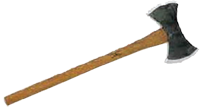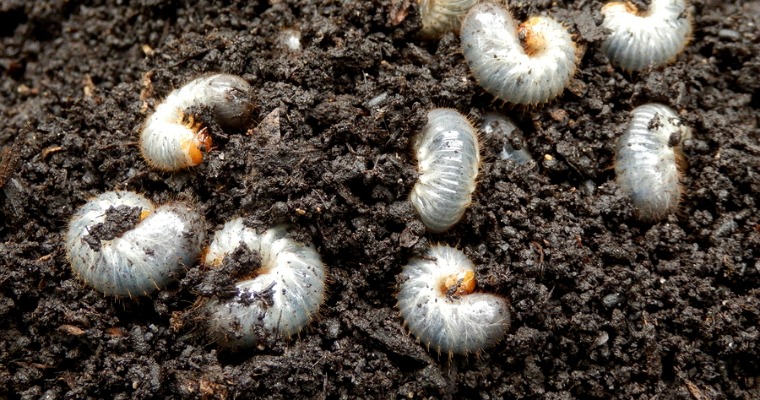Trees play an important role in the landscape of a residential home. But like all living organisms, they are susceptible to pests, including grubs. Most people disregard grubs as being harmless.
While most species shouldn’t cause any harm to your trees, there’s one variety that can destroy and kill otherwise healthy trees. To learn more about this grub and how to safeguard your trees from its grasp, keep reading.
The one grub that homeowners need to look for is the Tenlined June beetle grub. About 1-2 inches long, they feature white-colored bodies with brown heads – much like other grubs.
During the first couple years of larval development, Tenlined June beetles will spend their time digging tunnels in sand and soil in search of food and water.
The good news is that Tenlined June beetle grubs typically cause no major damage to plants. The bad news, however, is that they can, and will, cause damage to trees.
Once the grubs have transitioned into adult beetles, they won’t feed on trees. Until that time, however, the grubs pose a serious threat to trees, eating away at the root structures.
So, how do you know if your tree is suffering from a Tenlined June beetle infestation? Because the grubs remain underground, detection isn’t always easy. Some symptoms of an infection may include browning of the leaves, leaves dropping early, and stunted growth.
In addition to looking for these symptoms, you can also identify infestations by taking a sampling of the soil. Pull a 2-3′ sample of the soil around the tree, using caution not to further damage the tree’s roots, and look to see if there are any grubs present.
If you discover Tenlined June beetle grubs in your soil sample, you’ll need to take immediate action to remedy the infestation. Fumigating the soil is the most effective solution for dealing with an infestation.
But depending on the severity of the infestation, you may also have to remove the damaged tree. Some gardening and pest control companies offer these services, or you can perform it yourself.
The Tenlined June beetle grub is just one of the many threats posed to trees. As a homeowner, you should keep a close eye on the trees and plant life on your landscape for signs of these and other pests. The sooner you identify an infestation, the easier it will be to handle.
The Woodsman Company offers tree planting, tree pruning and shrub trimming, tree removal and stump grinding as well as a tree wellness program.
If we can help with any of your tree care needs give us a call at 512-846-2535 or 512-940-0799 or


I think it would be really sad to have your tree go down by grub worms. I have heard that they can be bad enough that you have to make sure to get a tree removal company to get the tree out before it causes damages to your home or yard. It would save a lot of costs in my mind.
These little guys can do some damage over time. I own a tree cutting business and have had to take care of some trees that have been destroyed by these things. It can be difficult to see them go down especially when you see a customer love a tree that she/he had growing up in. It is paramount in my opinion for trees to be inspected by the homeowners, because there are some signs that you can see before it gets too bad.
When gently digging in my new garden bed of Jeffries Garden Loam and planted with a row of young Magnolias (Little Gem). I was concerned to find several curled white grubs with three sets of front legs. I destroyed the grubs and am now concerned that I may have to treat the soil for others. At this stage the magnolias planted September 2018 are growing well. I live at [address redacted] and we have had some very hot weather but as this garden bed is automatically irrigated with an underground irrigation system I try not to disturb the soil. My plan was to turn the irrigation down to two or tree times a week very soon.
Do I need to treat the soil for these Grubs?
Hi Pam. It’s possible you may need to treat your soil for grubs. It would be a good idea to contact a local lawn care professional and have them make an assessment for you.
I told my pest control people that I had actually killed a few grubs at the base of my tree. I was sure that there were plenty more I was not seeing underground. They sent a young kid over who admitted that he had little experience dealing with these insects. I was told that a chemical pellet spread at base of tree and over grass was the answer. Three weeks later, my tree was dead. I feel after reading some of your solutions that the extermination co. Should be liable for a new tree. What do you think Ken?
Hi Richard. Thanks for your comment. However, there is no way for us to determine the reason your tree died and I wouldn’t want to speculate on it.
I had a beautiful tree I had to have cut down because of grubs.
Sorry to hear that Tina.
A few years ago I removed a few large ficus trees and had the stumps ground down. They hat in the earth for over a year decomposing. I eventually planted a few arborvitae trees.
While I placed them in the ground I discovered quite a few Grubs in the soil especially in the area that had the decomposing root base.
I had no idea how much damage Grubs can do to a root system of a tree until reading this information.
I’m pretty sure that many of the Grubs remain in the soil and have begun to establish themselves in my new arborvitae trees as it’s unlikely they just disappeared on their own.
Can you provide some advise on what steps I should take to ensure that my new arborvitae trees continue to thrive? They’re doing very well, but they take so long to establish, especially in a climate like Arizona: I would not want to have to lose any of them and have to start from scratch again.
Thanks for your help,
Steven
Hi Steven. Thanks for reading. We are not familiar with the trees or soil in Arizona. I would recommend contacting a local arborist or a landscape center in your area.
I’ve been watching the live oaks decline in our back yard for a few years. I was thinking it was due to a lack of rainfall but suddenly this fall/winter an armadillo has been digging hole after hole under the canopies of the affected oaks. I’m thinking they are digging for grubs. Putting two and two together maybe grubs have been damaging the tree roots?
I was concerned that our young Shumard oak was suffering this spring from February’s ice and cold—it has poor leaf development and a few bare limbs.
But as I was pulling the mulch away from the base of the trunk that the lawn guy had recently put in the ring around the tree, I found a BUNCH of grubs (dozens every few inches). I kept pulling the mulch back all around the ring and I removed HUNDREDS of those nasty grubs (tossing them into a bucket). Clearly it was the grub infestation that was causing the poor leaf development this spring—the tree appears really stressed.
Meanwhile, the turf around the tree and in the yard looks very healthy! I never would have known about the grub infestation if I hadn’t cleaned up after the lawn guy!
The local plant nursery recommended a treatment for the grubs, and my husband will be applying it to the tree ring and the rest of our yard and flower/shrub beds.
Now I’m looking up and down the street at a few more trees that seem sickly looking… and wondering if neighbors are having the same problem.
A tree removal service took down a huge silver maple tree in my back yard as the bark was showing signs of the trunk splitting below a fork in the tree. When cutting and splitting the trunk into firewood, we cane across about a 2 ft area with many grub type worms living in the center of the tree. What would these be, and how could this infestation have been avoided? The damage was about 3 ft up from the ground and did not appear to involve the roots. There were no apparent wounds in the bark other than the recent sign of bark splitting on both sides of the tree. I am so sad that this 50+ foot old maple was lost. Thanks for any information. I live in Northern Wisconsin.
After your read ,yes I’ve seen the grubs in a rotted apple tree stump I lost last year. And this year i lost a crab apple tree to same.its a shame the crab apple bloomed the most beautiful flowers I’d seen it produce in 24 years than died.. guess I better start an aggressive extermination routine. Also wondering is it possible for termites to survive in cold nw. Iowa.had bundles of lumber delivered to build steel type building.and some of the boards had colonies or channels of destruction within them . Pest control just said we dont have them around here,not likely. Lumber was branded from Pacific nw. .
Earlier this summer, I noticed that our row of evergreen trees were showing signs of browning and fatigue.
While I was cutting my lawn this week, I noticed Raccoon tracks going through the garden area.
Afterwards, I noticed a bunch of holes dug up along the tree line beside the garden.
All of this made me realize that raccoons dig for grubs and that the grubs were slowly killing my trees.